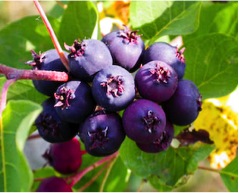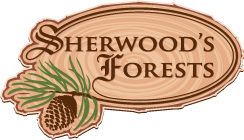Saskatoon Berries
Amelanchier alnifolia

Yummacious! (Photo courtesy Saskatoon Berry Institute)
Inventory tables are double rows to make them usable on small screens.
Common name and container in column 1.
Count is how many we think we have left. Price is per tree.
Height will be there next year, we hope.
Food -- Saskatoon
| Common Name Container |
Count Price |
Height (feet) |
|
| Saskatoon, Martin' #1 Std pot (3 qt) |
-18 $20.00 |
||
| Saskatoon, Martin' #1 Std pot (3 qt) |
37 $24.00 |
||
| Saskatoon, Martin' #2 Std pot (6 qt) |
-3 $20.00 |
||
| Saskatoon, Northline #1 Std pot (3 qt) |
11 $20.00 |
||
| Saskatoon, Smoky #1 Std pot (3 qt) |
30 $20.00 |
||
| Saskatoon, Smoky #2 Std pot (6 qt) |
-5 $20.00 |
||
| Saskatoon, Thiessen #1 Std pot (3 qt) |
34 $20.00 |
||
| Saskatoon, Thiessen #2 Std pot (6 qt) |
-6 $20.00 |
||
| Last Update: 2024-Jan-21 | |||
This shrub natively grows over a large part of North America. As a boy in Idaho I knew it as Serviceberry. That and Juneberry seem to be the most common names in the U.S. Saskatoon is Canadian, actually Cree, I think.
Locally wild Saskatoons seem to prefer south facing slopes, but I've found it as an understory shrub among the poplars. The leaves are distinctive: The end of the leaf near the stem is smooth. The other half is toothed.
The shrub typically grows 6-12 feet tall. Cultivars for fruit production are chosen from the shorter end of this range. One cultivar (Ovation) has been chosen for it's height and brilliant fall foliage. It's not a great producer, and is difficult to pick. But it is pretty.
Flowers are bee pollenated. Here on the farm it's usually bumble bees. Berries ripen in early July.
Saskatoons like their own company. Space fairly close in the row, and return their leaves to the base of the shrub in fall. I suspect there is a nutrient they can salvage from their leaves.
Best soil is sandy loam. Don't do well on poorly drained clay soils. If your soil is clay, plant them on a slope. This will improve drainage.
The berries are high in anthocyanins (responsible for the purple colour). There are a raft of polyphenols too -- antioxidants.
Saskatoons we carry vary from year to year. If you want a particular variety, order early.
Summary:
- Northline best processing fruit -- jam and pies.
- Theissen best fresh eating, sauces and juices. Not as strongly flavoured.
- Smokey best flavoured berry.
Honeywood
- Fruit: 13-15 mm diameter. Deep blue, with dark purple skin. High yield, large clusters.
- Bush: 5m high x 4m wide. Upright spreading structure. low suckering.
- Notes: Blooms later than other varieties. Irregular ripening suits U-pick operations.
Martin
- Fruit: 15 mm or larger. Deep blue skin when ripe. Excellent flavour. Medium yield.
- Bush: 3m high x 4m wide. Round bush. Moderate suckering.
Northline
- Fruit: Deep blue skin when ripe. 16 mm, full flavoured, sweet. Very high yild
- Bush: 4m high x 6m wide. Suckers.
- Notes: Tillage required to reduce suckering into aisles.
Nelson
- Fruit: 13mm tangy, acidic. Freshy.
- Bush: 4.5m high and wide.
- Notes: Some resistance to juniper rust. Flowers a week later than most cultivars.
Pembina
- Fruit: Deep blue, 14 mm, full flavoured, tangy to moderately sweet, high yield, slightly oval fruit on long clusters.
- Bush: 5 m high x 5 m wide. Upright, slightly spreading sructure. Few suckers.
Smoky
- Fruit: 14mm fruit. Mild, sweet flavour. Very high yield.
- Bush: 4.5m high and wide, upright, suckers profusely.
- Notes: Blooms later than others. This is one of the oldest commercial cultivars, and still accounts for most commercial production. Berries are often over 1/2" in diameter, and clusters tend to ripen evenly. 10-12 feet tall if you don't prune it.
Thiessen
- Fruit: 17mm Excellent flavour desicriped as fresh and juicy. High yield. Uneven ripening.
- Bush: 5m high x 6m wide, low suckering.
- Notes: Early blooming may be susceptible to spring frosts.
Parkhill
- Fruit Medium (12-15 mm) sweet and mild flavour. Medium to low yield.
- Bush: 1.5 m x 1.5 m.
- Notes: Dwarf form useful as an ornimental.
Ovation
- Fruit: Small. 8-12 mm. Strong flavour. Medium yield.
- Bush: 6 m high x 1.2 m wide.
- Notes: Used as a columnar ornamental, screening. Red leaves in fall. Picking requires ladder work.
Native
These are seed propagated from wild harvested fruit. They still produce good fruit, but the berries will be much smaller than the commercial ones (typically 1/4" to 3/8") As is common with domestication, they are more strongly flavoured than their commercial cousins too. As such they can be used in a mix containing fruit that runs to bland. Strawberry saskatoon pie is a common mix.
On special order, I can get Honeywood, Lee #3, Lee #8, Northline, Martin, Nelson, Parkhill. If you want large quantities, I need a year's notice.
Pests
Somewhat susceptible to cedar-apple rust, with the saskatoon substituting for the apple. Do not plant easter red cedar or junipers in close proximity. I've not heard of it being an issue here on the prairies, as we tend to be too dry. That said: I have two upright juninpers, and a native flat juniper about 75 feet away from a pair of saskatoons. So maybe I don't have any rust on either one of them.
Grasshoppers, rabbits and deer have been reported as pests. If you are going to fence the deer out, consider running turkeys to cope with the grasshopper problem -- you've got the fence anyway. Try with a heritage breed that is a bit brighter than some of the currently popular commercial breeds.
Care:
If you are serious about saskatoons for fruit, you need to get your own copy of:
Saskatoon Berry Production Manual
I used to point this link to the Alberta Government web site, but increasingly under the Kenney regime, Alberta Agriculture has seen many links break, and even more totally disappear.
While much of the manual concerns production, there are good sections on watering, pruning, fertilizing.
Sherwood's Forests is located about 75 km southwest of Edmonton, Alberta. Please refer to the map on our [Contact][5] page for directions.
Got something to say? Email me: sfinfo@sherwoods-forests.com
Interesting? Share this page.
Want to talk right now? Call me: (8 am to 8 pm only, please) 1-780-848-2548
Do not arrive unannounced. Phone for an appointment. Why? See Contact & Hours That same page gives our hours of operation.
Back to Top
Copyright © 2008 - 2021 S. G. Botsford
Sherwood's Forests is located about 75 km southwest of Edmonton, Alberta. Please refer to the map on our Contact page for directions.
